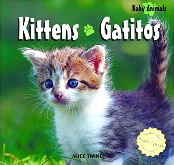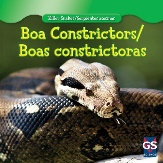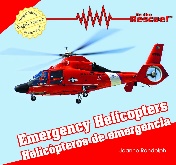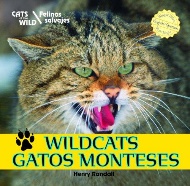-
 Animal lovers can't help but be fascinated by aardvarks, even if they think it's a little gross that these large animals use their long tongues to slurp up ants and termites. This bilingual book is full of enchanting photographs and interesting facts about these unusual-looking, but very interesting, animals.
Animal lovers can't help but be fascinated by aardvarks, even if they think it's a little gross that these large animals use their long tongues to slurp up ants and termites. This bilingual book is full of enchanting photographs and interesting facts about these unusual-looking, but very interesting, animals. -
 Bilingual learners will be thrilled with this outdoor guidebook about bobcats. They are rarely seen in the open, but thousands of these animal hunt throughout much of North America. These powerful predators can take down prey that is much larger than they are. Engaging text in English with standard Latin-American Spanish translation is supported by dramatic, colorful photographs.
Bilingual learners will be thrilled with this outdoor guidebook about bobcats. They are rarely seen in the open, but thousands of these animal hunt throughout much of North America. These powerful predators can take down prey that is much larger than they are. Engaging text in English with standard Latin-American Spanish translation is supported by dramatic, colorful photographs. -
 Amazing mountain animals fill the pages of this exciting series. Redesigned with new features, each book invites readers to discover the world of creatures that make their home in high places. Young learners will read about each animals unique physical characteristics, behavior, and adaptations to their environment. Through fascinating facts and brilliant photographs, these books paint a vibrant picture of the incredible array of animal life in the mountains.
Amazing mountain animals fill the pages of this exciting series. Redesigned with new features, each book invites readers to discover the world of creatures that make their home in high places. Young learners will read about each animals unique physical characteristics, behavior, and adaptations to their environment. Through fascinating facts and brilliant photographs, these books paint a vibrant picture of the incredible array of animal life in the mountains. -
 In this riveting bilingual caption book, young naturalists will learn about the group dynamics of a pride of lions. This book is written in English and standard Latin-American Spanish and provides both a fun introduction to these fearsome and fascinating big cats and an opportunity to acquire vocabulary in another language.
In this riveting bilingual caption book, young naturalists will learn about the group dynamics of a pride of lions. This book is written in English and standard Latin-American Spanish and provides both a fun introduction to these fearsome and fascinating big cats and an opportunity to acquire vocabulary in another language. -
 The mysterious lynx is secretive, stealthy, and fierce. Bilingual readers are treated to a fun narrative in English with standard Latin-American Spanish translation about these shy cats that live in North America and Europe. Eye-catching photographs and a picture glossary help build emergent language and reading skills.
The mysterious lynx is secretive, stealthy, and fierce. Bilingual readers are treated to a fun narrative in English with standard Latin-American Spanish translation about these shy cats that live in North America and Europe. Eye-catching photographs and a picture glossary help build emergent language and reading skills. -
 This lively caption book shows young bilingual learners what life is like in a meerkat mob. The meerkats world is described in both English and standard Latin-American Spanish. Colorful photographs reveal the playful side of these fascinating animals as they care for their young, look for food, and stand watch over the mobs burrow.
This lively caption book shows young bilingual learners what life is like in a meerkat mob. The meerkats world is described in both English and standard Latin-American Spanish. Colorful photographs reveal the playful side of these fascinating animals as they care for their young, look for food, and stand watch over the mobs burrow. -
 Even though its smaller than many killer snakes, the death adder is still very dangerous. Readers will soon discover exactly why this snake is so aptly named. Colorful photographs show this venomous snake in action as readers learn exciting facts about how death adders hunt, eat, and survive. Excellent Spanish translations provide engaging support for bilingual learners.
Even though its smaller than many killer snakes, the death adder is still very dangerous. Readers will soon discover exactly why this snake is so aptly named. Colorful photographs show this venomous snake in action as readers learn exciting facts about how death adders hunt, eat, and survive. Excellent Spanish translations provide engaging support for bilingual learners. -
 As the world's population expands, so too does the risk of communicable disease and global pandemics. Consequently, healthcare has assumed a greater centrality in the public consciousness both in the United States and around the world. With various national and international organizations dedicated to epidemiological research and disease control, societal welfare has become an increasingly significant aspect of public policy. The historical, legal, and scientific factors that form the basis of public health locally and globally are the subjects of this relevant and revealing volume.
As the world's population expands, so too does the risk of communicable disease and global pandemics. Consequently, healthcare has assumed a greater centrality in the public consciousness both in the United States and around the world. With various national and international organizations dedicated to epidemiological research and disease control, societal welfare has become an increasingly significant aspect of public policy. The historical, legal, and scientific factors that form the basis of public health locally and globally are the subjects of this relevant and revealing volume. -
 Chemistry is often a daunting subject for students, fostering a bewilderment that sets in upon their first encounter with the Periodic Table. This book demystifies an important aspect of the subject--chemical reactions--and demonstrates exactly how fascinating and fun chemistry can be. Starting out by explaining just what a chemical reaction is--and what it isn't--the book details in accessible language the various kinds of chemical reactions that are possible. It draws upon readily comprehensible everyday examples, like rusting metal, baking bread, battery power, digestion, rotting eggs, and burning candles. The book then turns to a survey of the history of chemical research, beginning in the Ancient and Classical Worlds, progressing to the Medieval alchemists and Renaissance innovators, and ending with the leading lights of modern chemistry. Readers will be introduced to luminaries such as Antoine Lavoisier, John Dalton, Louis Pasteur, Dmitri Mendeleyev, the Curies, and Ernest Rutherford. It concludes with an inspiring examination of how current research and cutting edge developments are using chemistry and chemical reactions to save lives and insure continued life on Earth. This book amply illustrates the accessibility, relevance, and gee-whiz fun of chemical reactions.
Chemistry is often a daunting subject for students, fostering a bewilderment that sets in upon their first encounter with the Periodic Table. This book demystifies an important aspect of the subject--chemical reactions--and demonstrates exactly how fascinating and fun chemistry can be. Starting out by explaining just what a chemical reaction is--and what it isn't--the book details in accessible language the various kinds of chemical reactions that are possible. It draws upon readily comprehensible everyday examples, like rusting metal, baking bread, battery power, digestion, rotting eggs, and burning candles. The book then turns to a survey of the history of chemical research, beginning in the Ancient and Classical Worlds, progressing to the Medieval alchemists and Renaissance innovators, and ending with the leading lights of modern chemistry. Readers will be introduced to luminaries such as Antoine Lavoisier, John Dalton, Louis Pasteur, Dmitri Mendeleyev, the Curies, and Ernest Rutherford. It concludes with an inspiring examination of how current research and cutting edge developments are using chemistry and chemical reactions to save lives and insure continued life on Earth. This book amply illustrates the accessibility, relevance, and gee-whiz fun of chemical reactions. -
 The Internet brought about a total revolution in the world of information. Today, anyone with an Internet connection can access a wealth of information online. As our access to data increases, copyright laws struggle to keep up. This book examines how copyright law has been applied to online content, the emerging open source movement, fair use, proper citation practice, and the ethics of using and citing online information. It is an invaluable resource for today's students.
The Internet brought about a total revolution in the world of information. Today, anyone with an Internet connection can access a wealth of information online. As our access to data increases, copyright laws struggle to keep up. This book examines how copyright law has been applied to online content, the emerging open source movement, fair use, proper citation practice, and the ethics of using and citing online information. It is an invaluable resource for today's students.






















